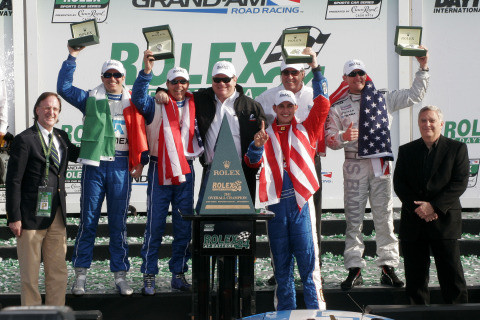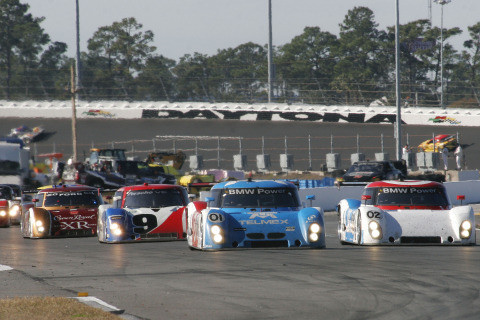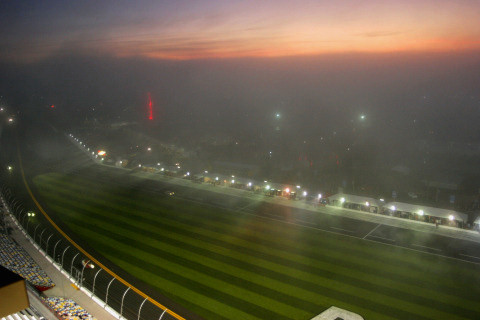The Way It Is/ Chasing history
by Gordon Kirby I didn't go to the Rolex 24 Hours this year. In fact, I'm missing the 500 as well because I'm embroiled with the final stages of editing, photo-editing, caption-writing and helping lay out and design my epic history of Carl Haas Auto and Newman/Haas Racing. It's a giant book covering more than fifty years of racing which I've been working on for more than two years. In an upcoming column I'll let you know the details of who will publish the book and where it will be available when it comes off the press early next summer.
I didn't go to the Rolex 24 Hours this year. In fact, I'm missing the 500 as well because I'm embroiled with the final stages of editing, photo-editing, caption-writing and helping lay out and design my epic history of Carl Haas Auto and Newman/Haas Racing. It's a giant book covering more than fifty years of racing which I've been working on for more than two years. In an upcoming column I'll let you know the details of who will publish the book and where it will be available when it comes off the press early next summer.
Obviously, I missed a pretty good race at Daytona with the first four cars on the lead lap at the end. You have to congratulate Chip Ganassi and his Grand-Am team led by Mike Hull, Tim Keen and veteran driver Scott Pruett. It's quite an accomplishment for the team to score its fourth win in six years and record Ganassi's first one-two sweep. The first three wins in 2006-'08 came with Lexus engines but last weekend's win was earned with BMW power which Chip's team switched to last year. It was BMW's first Daytona victory in twenty-five years.
As I watched Speed's excellent coverage from Daytona I couldn't help reflecting on many previous Daytona 24 hours I've had the pleasure to cover. One of my favorite memories was encountering Al Holbert in the back of the pits around three or four am in maybe 1988 when Holbert's factory-backed team dominated IMSA's once-great Camel GTP series. Co-driving one of his Porsche 962 turbos with Derek Bell, Al Unser Jr and Chip Robinson, Holbert won the Daytona 24 hours back-to-back in 1986 and '87 but this particular year he had problems. His driving suit was unaccustomely dishevelled and he looked exhausted. A philosophical and deeply religious soul Holbert, shook his head and grinned.
"Every year I say never again," he remarked. "But every year we do it. We must be crazy. When I get to this stage of the night--if I get to this part of the night--I know I'm crazy."

© LAT USA
But Daytona's overall importance on the international calendar is nothing like it was from 1964-'72 when it was the opening round of the World Sports Car championship. Back then Daytona and Sebring were the opening two races of the FIA's sports car series which featured only half a dozen major races, including Le Mans of course, plus the Nurburgring 1000Ks and the Targa Florio and 1000K races at Spa and Monza.
From its founding in 1953 through its death at the end of 1992 the World Sports Car championship went through many iterations, as racing categories tend to, but it never found a leader like Bernie Ecclestone or Bill France. Open road races like the Mille Miglia and Targa Florio became outdated over the years while Daytona and Sebring thrived as part of the original world sports car championship through 1981.
Daytona's endurance event was founded in 1962 as a three-hour race, won famously by Dan Gurney's Lotus 19, and joined the World Sports Car series in 1964 as a twelve-hour race before expanding to twenty-four hours in '66. Phill Hill/Pedro Rodriguez won in '64 aboard at NART Ferrari 250GTO with Ken Miles/Lloyd Ruby scoring back-to-back wins in 1965 and '66 driving a Shelby American Ford GT40 in '65 and a Ford mk II in '66. In 66, Miles and Ruby led a Ford sweep with Dan Gurney/Jerry Grant finishing second in another Shelby mk II and Mark Donohue/Walt Hansgen taking third in a Holman & Moody mk II. The following year Ferrari came through to take its own one-two-three sweep with Chris Amon/Lorenzo Bandini winning aboard a factory 330P4 and Mike Parkes/Lodovico Scarfiotti finishing second in a similar factory P4.
Sebring was there from the start of the World Sports Car championship in 1953 as the series' season-opener establishing its great history with superstar winners like Juan-Manuel Fangio, Stirling Moss, Mike Hawthorn, Peter Collins, Phil Hill, Dan Gurney, John Surtees, Mario Andretti and Jacky Ickx embracing a string of wins by the factory Ferrari team from the fifties through the seventies.
Since the early eighties however Daytona and Sebring have been somewhat lesser races sanctioned by IMSA or ALMS or Grand-Am. Under John Bishop's leadership IMSA thrived for many years from the Porsche 935 and 962 eras through TWR's Jaguar XJR9 & 12s, Nissan's NPTI GTP cars and All American Racers Eagle-Toyotas. But then the thread unravelled. Bishop retired, his leadership vanished and out of IMSA's ashes came two separate series. There's a new IMSA the sanctioning body for the American Le Mans Series owned by Don Panoz with Sebring and the Petit Le Mans as its keystone events. And there's the Grand-Am series, run out of ISC's offices in Daytona, with the Rolex 24 as its defining event.

© LAT USA
Le Mans remains the holy crucible of sports car racing and with the FIA's help the ACO (Automobile Club de l'Ouest) has strengthened its position by reinventing the old world championship as the Intercontinental Le Mans Cup. Le Mans is its seminal event of course and we're lucky that Sebring's 12 hours and the Petit Le Mans 1,000Ks at Road Atlanta in the fall are also rounds of the Intercontinental Le Mans Cup. the series features only seven races, much like the WSC's grand old days, with six-hour races at Spa, Imola, Silverstone and Zuhai completing the 2011 schedule.
Without doubt the FIA and the ACO are committed to developing new technology and showcasing it in the Intercontinental Cup. As I've written the four cylinder turbo age is fast-arriving in racing as the automobile industry moves to smaller more efficient cars and engines. The four-cylinder turbo 'Global Racing Engine' is a key component of FIA president Jean Todt's agenda as the sport moves to downsize in Formula One, sports car racing and everywhere else too.The FIA has mandated four-cylinder turbos for F1 in 2013 of course, while Audi moved two years ago from a turbo V12 to a turbo V10 and will race a turbo V6 this year in its new R18 coupe Le Mans car. And IndyCar essentially is going down the same road.
For its part the ALMS is married to the concept of smaller, more efficient and 'greener' racing and Scott Atherton and his team are committed to working with the FIA and ACO in the years ahead as they have in the past. This connection is the ALMS's biggest strength and perhaps its biggest weakness too. The strength comes from its direct connection to Le Mans and the chance to enjoy some of the most advanced cars and teams in the sport. The weakness is that there's little room for the privateer or 'little guy'.
Meanwhile, the Grand-Am has gone a different direction trying to cater to smaller teams with less technological development and more restricted cars and engines. It's mantra is the same as its parent NASCAR--close, competitive racing rather than showcasing technology. So the ALMS and Grand-Am are diametrically opposed in most ways.
The great challenge for sports car racing always has been about trying to strike a balance in both performace and economics between the factory or factory-backed teams and the privateers. It remains the big challenge in the 21st century and there are no easy solutions.

© LAT USA
Over the decades American racing's biggest failing has been a continuing story of a series of different sanctioning bodies struggling for power in both open-wheel and sports car racing and most other forms of the sport. The AAA ruled through most of the American racing's first fifty years until its decision in 1955 to pull out of racing. Over the succeeding decades we had the SCCA versus USAC versus IMSA versus CART versus IRL, let alone the separate worlds of NHRA and IHRA drag racing, off-road racing, etc. Of course, the Frances and NASCAR took control of stock car racing, pushing out or eliminating the likes of USAC, ARCA, etc. from being major league players in stock car racing while Wally Parks did the same with the NHRA.
In a perfect world American sports car racing would enjoy a single all-powerful sanctioning body and the Rolex 24 at Daytona would be part of the Intercontinental Le Mans Cup with the same stars, cars and teams contesting Daytona and Sebring. Wouldn't that be lovely to see again? It would be a great way to kick-off the sports car season and a real shot in the arm for sports car racing in America.
Bill France Sr. worked hard to forge a close relationship with the FIA to make American sports car racing an integral part of international racing, therefore making it more prestigious and important both at Daytona and across America. Wouldn't it be great to see 'Big Bill's' international spirit reintroduced to American sports car racing? In today's global economy you would think it would be essential.
Auto Racing ~ Gordon Kirby
Copyright 2011 ~ All Rights Reserved
Copyright 2011 ~ All Rights Reserved
Top of Page